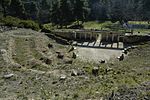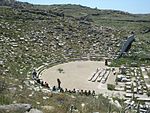Ancient Greek theater
Under the title Ancient Greek Theater , a selection of 15 theaters from ancient Greece was entered by Greece in its tentative list for UNESCO World Heritage in 2014.
List of theaters
| place | region | Regional district | theatre | construction time | particularities | image |
|---|---|---|---|---|---|---|
| Athens | Attica | Athens center | Dionysus Theater | around 325 BC Chr. | Theater for 14,000-17,000 spectators. 62/61 BC Addition of the Roman scaenae frons . | |
| Oropos | Attica | Eaststatica | Amphiareion theater | 3rd century BC Chr. | Theater belonging to the sanctuary of Amphiaraos , the god of healing . The raised stage ( logeion ) was suitable for newer plays that managed without a choir and emphasized the individual role of the actor. | |
| Epidaurus | Peloponnese | Argolis | Epidaurus Theater | early 3rd century BC Chr. | Theater for 12,000–12,500 spectators. According to Pausanias, it was built at the time of the architect Polyklet the Younger (365/60 BC). | |
| Megalopoli | Peloponnese | Arcadia | Megalopolis Theater | 4th century BC Chr. | Theater for 17,000–21,000 spectators. According to Pausanias, the largest theater in Greece. Because of its size, it is also the venue for the Federal Assembly of Arcadians. | |
| Argos | Peloponnese | Argolis | Argos Theater | around 300 BC Chr. | Theater for 20,000 spectators, mentioned in Pausanias . Renovation at the time of Emperor Hadrian ; In late antiquity the orchestra was prepared for naumachia and water features. | |
| Delphi | Central Greece | Fokida | Delphi Theater | around 250 BC Chr. | Completion after 160 BC Under Eumenes II. , Inscription on a pillar monument. Mentioned by Pausanias: "very worth seeing theater." On the eastern wall, numerous inscriptions about the release of slaves. | |
| Eretria | Central Greece | Euboea | Theater of Eretria | 4th century BC Chr. | The first construction phase is only preserved in the remains of the stage building, the deepening of the cavea in the slope comes from the second construction phase (3rd century). A special feature are the tracks of a rolling platform ( Ekkyklema ). | |
| Larisa | Thessaly | Larisa | Larissa I Theater | late 3rd century BC Chr. | After removing the overbuilding, this older Larissa theater is clearly visible again. | |
| Delos | South Aegean | Mykonos | Delos Theater | before 246 BC Chr. | Theater for 5,500 spectators. Stage building as a rectangular hall supported by pillars. | |
| Milos | South Aegean | Milos | Melos Theater | Hellenistic theater, rebuilt in Roman times, up to eight rows of marble seats still exist. Seat inscriptions, including for the "hymn singers". | ||
| Lindos | South Aegean | Rhodes | Lindos Theater | Hellenistic theater, the seating steps cut into the rock have been preserved. | ||
| Iniades | West Greece | Aetolia-Acarnania | Oeniadai Theater | Hellenistic theater with benches carved into the rock, some with name inscriptions. | ||
| Dodona | Epirus | Ioannina | Theater of Dodona | 3rd century BC Chr. | Theater for 14,000-18,000 spectators. One of the earliest examples of a raised stage with doorways ( thyromata ). Converted into an arena during the Roman Empire. | |
| Aptera | Crete | Chania | Aptera Theater | Probably Hellenistic theater made of ashlar masonry, additions with bricks. The theater was connected to a temple. | ||
| Maronia | East Macedonia and Thrace | Rodopi | Maronia Theater | Lower 3 rows of seats retained. The orchestra was converted into a Kolymbethra or arena during the imperial era. |
Justification of the outstanding universal meaning
The theater was a special line of ancient Greek culture. It was architecturally adapted to changing requirements from the classical to the Hellenistic to the Roman period, in accordance with the developing drama literature.
To justify the outstanding universal importance of the ancient Greek theater according to the criteria for the UNESCO World Heritage , the following is cited:
- The ancient theaters are functional buildings, they are the first examples of a type of architecture that still exists today (criterion i).
- Theaters were already regarded by Pausanias as the epitome of Greek civilization (criterion ii).
- The seating arrangement in the theater reflects the social order and can therefore be seen as a visible expression of democracy (criterion iii).
- Theaters are technical masterpieces in terms of their acoustics (criterion iv).
- You make optimal use of the natural conditions, such as the location on a slope (criterion v).
- In such theaters, the works of Aeschylus , Sophocles , Euripides and Aristophanes were performed for the first time and are still performed today (criterion vi).
Web links
- UNESCO World Heritage Center, Tentative Lists: Ancient Greek Theaters
Individual evidence
- ↑ Ancient Greek Theaters. In: whc.unesco.org. UNESCO World Heritage Center, accessed June 8, 2020 .
- ↑ a b Direction State Archeology Mainz, Theatrum: ATHEN, Dionysos Theater
- ↑ a b Directorate State Archeology Mainz, Theatrum: OROPOS, Amphiaraos-Heiligtum
- ^ A b Direction State Archeology Mainz, Theatrum: Epidauros, Theater
- ^ A b Direction State Archeology Mainz, Theatrum: MEGALOPOLIS
- ^ A b Directorate State Archeology Mainz, Theatrum: ARGOS, large theater
- ↑ a b c Direction State Archeology Mainz, Theatrum: DELPHI, Apollon-Heiligtum
- ↑ a b Directorate State Archeology Mainz, Theatrum: ERETRIA, Euböa
- ^ A b Direction State Archeology Mainz, Theatrum: Larissa, first theater
- ^ A b Direction State Archeology Mainz, Theatrum: DELOS, Städtisches Theater
- ^ Directorate State Archeology Mainz, Theatrum: MELOS
- ^ Directorate State Archeology Mainz, Theatrum: LINDOS
- ^ Directorate State Archeology Mainz, Theatrum: OINIADAI
- ^ A b Direction State Archeology Mainz, Theatrum: DODONA (Epirus) Zeus sanctuary
- ^ Directorate State Archeology Mainz, Theatrum: APTERA, Palaiokastro
- ^ Directorate State Archeology Mainz, Theatrum: MARONEIA













